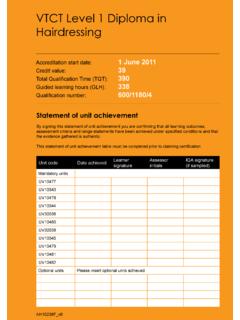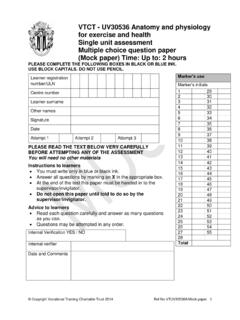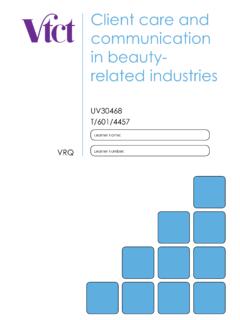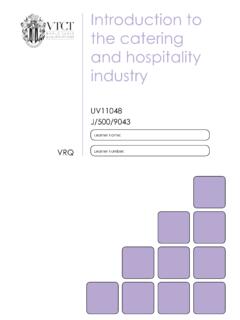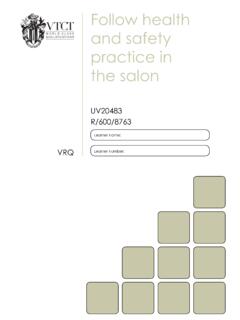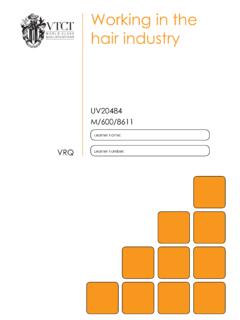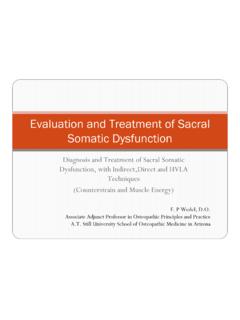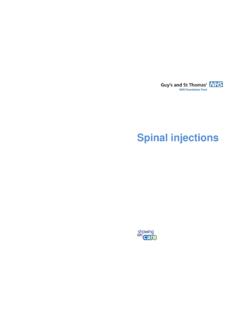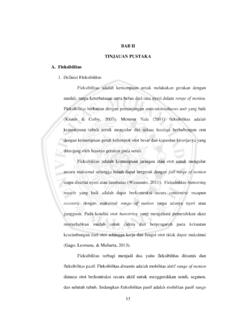Transcription of Conducting subjective and objective assessment - VTCT
1 Learner name:Learner number:D/506/7501 VRQUSP46 Conducting subjective and objective assessmentBy signing this statement of unit achievement you are confirming that all learning outcomes, assessment criteria and range statements have been achieved under specified conditions and that the evidence gathered is statement of unit achievement table must be completed prior to claiming certification. Unit codeDate achievedLearner signatureAssessor initialsIV signature (if sampled)Assessor nameAssessor signatureAssessors initialsAssessor number (optional)Assessor tracking tableStatement of unit achievementAll assessors using this Record of assessment book must complete this table. This is required for verification is the specialist awarding organisation for the Hairdressing, Beauty Therapy, Complementary Therapy, Hospitality and Catering and Sport and Active Leisure sectors, with over 50 years of is an awarding body regulated by national organisations including Ofqual, SQA, DfES and is a registered charity investing in education and skills but also giving to good causes in the area of facial disfigurement.
2 USP46 Conducting subjective and objective assessmentThe aim of this unit is to develop the skills, knowledge and understanding needed to analyse information gathered from subjective and objective client assessments. You will also develop detailed knowledge of the bony and soft structures of the major joints of the body, factors that may predispose clients to injury, factors that may influence clients ability to recover from injury, postural deviations, ageing and the pathophysiology of common muscle and tendon injuries. You will be taught a variety of objective testing methods, to include: range of movement (active, passive and resisted), postural analysis and a range of functional and special tests. This will include interpretation of the findings and ability to evaluate each method critically. Ultimately, from the information gathered, you will be able to devise appropriate treatment plans supported with rationale for valueLevel Observation(s)External paper(s)507450On completion of this unit you will:Learning outcomesConducting subjective and objective assessment1.
3 Be able to conduct subjective and objective assessment2. Be able to devise a sport massage treatment plan3. Understand the anatomy and physiology of the major joints of the body4. Understand the influences and effects of client information on treatment planning5. Understand the effects of anatomy, physiology and pathology on human function6. Understand the principles and practice of objective assessment techniquesYou need to meet the same standard on a regular and consistent basis. Separating the assessments by a period of at least two weeks is recommended as competence must be demonstrated on a consistent and regular Range All ranges must be practically Knowledge outcomes There must be evidence that you possess all the knowledge and understanding listed in the Knowledge section of this unit. In most cases this can be done by professional discussion and/or oral questioning. Other methods, such as projects, assignments and/or reflective accounts may also be used.
4 6. Tutor/Assessor guidance Your tutor/assessor must adhere to the assessment Guidance and Evidence Requirements for this unit. This can be found under documents on the relevant qualification page at You will be guided by your tutor/assessor on how to achieve learning outcomes and ranges in this unit. All outcomes and ranges must be achieved. 7. External paper There is no external paper requirement for this requirements1. Environment Evidence for this unit may be gathered within the workplace or realistic working environment (RWE).2. Simulation Simulation is not allowed in this unit. 3. Observation outcomes Competent performance of Observation outcomes must be demonstrated on at least five occasions. Assessor observations, witness testimonies and products of work are likely to be the most appropriate sources of performance evidence.
5 Professional discussion may be used as supplementary evidence for those criteria that do not naturally occur. Achieving observation outcomesAchieving observationsand range USP46 Your assessor will observe your performance of practical tasks. The minimum number of competent observations required is indicated in the Evidence requirements section of this may not always naturally occur during a practical observation. In such instances you will be asked questions to demonstrate your competence in this area. Your assessor will document the criteria that have been achieved through professional discussion and/or oral questioning. This evidence will be recorded by your assessor in written form or by other appropriate assessor will sign off a learning outcome when all criteria have been competently guidanceYour tutor/assessor must adhere to the assessment Guidance and Evidence Requirements for this unit. This document will give guidance for the tutor/assessor on breadth and depth of content that must be covered in this unit.
6 This can be found under the documents tab on the relevant qualification page at Achieving rangeThe range section indicates what must be covered. Ranges should be practically demonstrated as part of an observation. Your assessor will document the portfolio reference once a range has been competently outcome 1 ObservationsYou can:Observation45 OptionalDate achievedCriteria questioned orallyPortfolio referenceAssessor initialsLearner signatureObservation123 Date achievedCriteria questioned orallyPortfolio referenceAssessor initialsLearner signature*May be assessed by supplementary able to conduct subjective and objective assessmenta. Carry out subjective assessments of clientsb. Obtain consent for objective assessmentsc. Carry out objective assessments of clientsd. Record client information in accordance with professional practice requirementse. Store clients information as legally requiredUSP465 Learning outcome 2 You can:Be able to devise a sport massage treatment plana.
7 Devise treatment planb. Explain rationale for chosen massage interventionsc. Present massage interventions and rationale to clientsd. Obtain consent for treatmentObservation45 OptionalDate achievedCriteria questioned orallyPortfolio referenceAssessor initialsLearner signatureObservation123 Date achievedCriteria questioned orallyPortfolio referenceAssessor initialsLearner signature*May be assessed by supplementary *You must practically demonstrate that you have:Carried out objective testing on all major jointsPortfolio referenceAnkle and footKneeHipShoulderElbowWrist/handSpineI dentified all structures of major jointsPortfolio referenceSoft structuresBony landmarksJoint end feelUSP467 Achieving knowledge outcomesDeveloping knowledgeYou will be guided by your tutor and assessor on the evidence that needs to be produced. Your knowledge and understanding will be assessed using the assessment methods listed below*: Projects Observed work Witness statements Audio-visual media Evidence of prior learning or attainment Written questions Oral questions Assignments Case studies Professional discussionWhere applicable your assessor will integrate knowledge outcomes into practical observations through professional discussion and/or oral questioning.
8 When a criterion has been orally questioned and achieved, your assessor will record this evidence in written form or by other appropriate means. There is no need for you to produce additional evidence as this criterion has already been knowledge and understanding outcomes may require you to show that you know and understand how to do something. If you have practical evidence from your own work that meets knowledge criteria, then there is no requirement for you to be questioned again on the same topic.*This is not an exhaustive outcome 3 Understand the anatomy and physiology of the major joints of the bodyYou can:Portfolio reference a. Identify bony structures associated with the major jointsb. Explain the functions of bony structures associated with the major jointsc. Identify soft tissue structures located at the major jointsd. Explain the function of soft tissue structures located at the major jointse. Explain the different types of joint -end feelUSP469 Learning outcome 4 Understand the influences and effects of client information on treatment planningYou can:Portfolio referencea.
9 Explain factors which may predispose clients to injury and dysfunctionb. Explain how factors may influence a client s ability to recover from injuryc. Give examples of how subjective information may influence treatment planningd. Identify reasons for treatment deferral and referral USP4610 Learning outcome 5 Understand the effects of anatomy, physiology and pathology on human functionYou can:Portfolio referencea. Describe the characteristics of common postural typesb. Explain the effects of postural deviationsc. Describe the pathophysiology of common injuries/soft tissue dysfunctiond. Explain how the ageing process affects the musculo-skeletal systems USP4611 Learning outcome 6 Understand the principles and practice of objective assessment techniquesYou can:Portfolio referencea. Explain the methods and purpose for a range of objective assessment techniques: asymmetry palpation range of movement (Active, Passive, Resisted) postural analysis functional tests special tests b.
10 Explain how to interpret findings for each objective assessment techniquec. Critically evaluate the range of objective assessment methods used to gather information USP4612 USP4613 Learning outcome 2: Be able to devise a sport massage treatment planDevise treatment plan: From subjective and objective information gathered, meet client rationale: Verbal to client, for chosen massage massage interventions and rationale to clients: Present verbally to consent: Verbal, written (signature), prior, outcome 1: Be able to conduct subjective and objective assessmentThis section provides guidance on the recommended knowledge and skills required to enable you to achieve each of the learning outcomes in this unit. Your tutor/assessor will ensure you have the opportunity to cover all of the unit out subjective assessment : Age and occupation, sport and leisure activities, previous medical history, previous injuries, medication, other lifestyle factors (stress, diet, dependants), aims and objectives of treatment, perceived problem, site and spread of symptoms, behaviour of symptoms, onset and duration of symptoms, pain scale, aggravating and relieving consent for objective assessment : Verbal, written, prior to and during assessment , practitioner explains nature and purpose of assessment , risks, alternatives, out objective assessments: Asymmetry, palpation, range of movement active, passive, resisted, postural analysis, functional tests, special information: SOAP format, in accordance with requirements (legal, professional practice).
